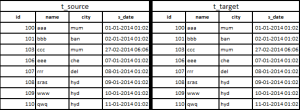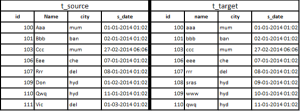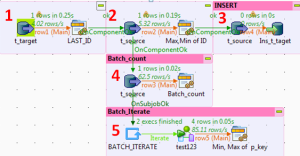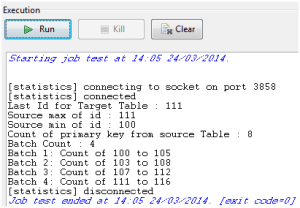This blog will talk about how to make Batch count for Incremental loading in Talend (TOS_5.3).
First all we have t_source and t_target tables
Both Tables have (t_source,t_target) data like this….
Objective
INSERT into t_source
We inserted one record into t_source
Insert into t_source(id,name,city,s_date) values (111,’vic’,’del’,’2014-03-01 01:02:00′)
UPDATE from t_source
We updated from t_source
Update t_source set name=’don’,s_date=’2014-02-01 01:02:00′ where id = 109;
DELETE from t_source
We deleted from t_source
Delete from t_source where id = 108;
Finally we have records from t_source table and t_target tables
We want make Batch count in TALEND(TOS)
We created one job…
Details of Job
Subjob (1)
We are fetched max(id) from t_target table and we updated into property variable
context.last_id = input_row.id;
Subjob (2)
We are fetching min (id) and max (id) from t_source and we updated into property variables
context.sr_max_id = input_row.max_id;
context.sr_min_id = input_row.min_id;
Subjob (3)
we are selecting from t_source
select * from t_source where id > “+context.last_id+” order by id
and insert into t_target table by primary key is id
Subjob(4)
we need to count between primary key from t_source
select count(*) as batch_count from t_source where id between “+context.sr_min_id+” and “+context.sr_max_id+”
and updated into property variable. We want to calculate Batch count
We will define by divide count (context.MT_COUNT = 5) . context.max_count, context.min_count is 0 before Execution of job.
context.count = input_row.count;
System.out.println(“Count of primary key from source “+context.UPLOAD_FILE_NAME+” Table : “+context.count);
int x = (context.count / context.MT_COUNT) + 3;
context.batch_count = x;
System.out.println(“Batch Count : “+context.batch_count);
context.max_count = context.MT_COUNT;
context.min_count = context.sr_min_id ;
context.max_count = context.sr_min_id + context.max_count;
SubJob (5)
We will iterate by context.batch_count. We have another job(test123) by Iterating.
1.Test123 Job
We are printing Batch count min_count to max_count
System.out.println(“Batch “+Numeric.sequence(“s1″,1,1)+”: Count of “+context.min_count+” to “+context.max_count);
b. Subjob(5.2)
We are selecting from t_source between primary key
select * from t_source where id >= “+context.min_count+” and id <= “+context.max_count+” order by id
and collects data into Buffer output
c. SubJob (5.3)
We compared by inner join from Buffer input(t_source) and t_target tables in tmap. If any reject output will be there then updated into t_target.
T_target sql query: select * from t_target where id >= “+context.min_count+” and id <= “+context.max_count+” order by id
d. SubJob (5.4)
We compared by left outer join from t_target and Buffer input(t_source) in tmap. We filtered t_source.id == 0 and if any output is there then deleted
T_target sql query: select * from t_target where id >= “+context.min_count+” and id <= “+context.max_count+” order by id
And we have t_javarow(Min, Max of p_key)
In that,
context.min_count = input_row.id;
context.max_count = context.min_count + context.MT_COUNT;
Results
We Executed the job by defined (property variables)MT_COUNT = 5.
Finally we have records from t_source and t_target.
Thanks & regards
Vishwanth suraparaju

Best Open Source Business Intelligence Software Helical Insight is Here






